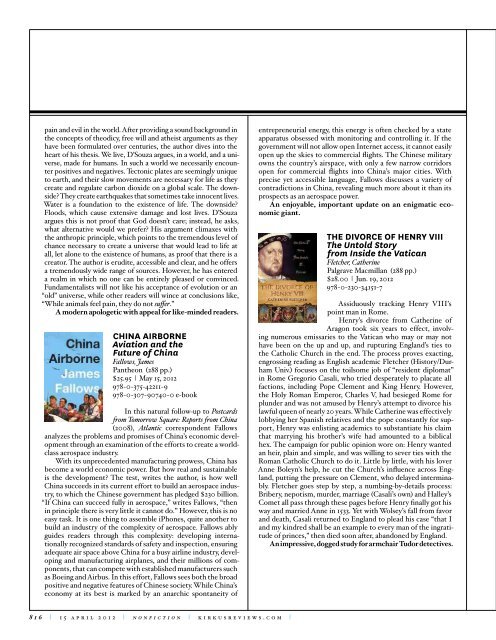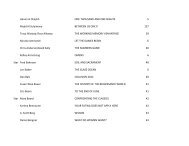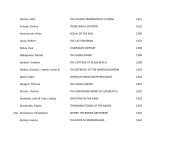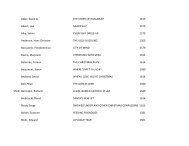nonfiction
nonfiction
nonfiction
You also want an ePaper? Increase the reach of your titles
YUMPU automatically turns print PDFs into web optimized ePapers that Google loves.
“The conclusions don’t surprise,<br />
but crackerjack reporting crackles throughout.”<br />
from the ball<br />
pain and evil in the world. After providing a sound background in<br />
the concepts of theodicy, free will and atheist arguments as they<br />
have been formulated over centuries, the author dives into the<br />
heart of his thesis. We live, D’Souza argues, in a world, and a universe,<br />
made for humans. In such a world we necessarily encounter<br />
positives and negatives. Tectonic plates are seemingly unique<br />
to earth, and their slow movements are necessary for life as they<br />
create and regulate carbon dioxide on a global scale. The downside<br />
They create earthquakes that sometimes take innocent lives.<br />
Water is a foundation to the existence of life. The downside<br />
Floods, which cause extensive damage and lost lives. D’Souza<br />
argues this is not proof that God doesn’t care; instead, he asks,<br />
what alternative would we prefer His argument climaxes with<br />
the anthropic principle, which points to the tremendous level of<br />
chance necessary to create a universe that would lead to life at<br />
all, let alone to the existence of humans, as proof that there is a<br />
creator. The author is erudite, accessible and clear, and he offers<br />
a tremendously wide range of sources. However, he has entered<br />
a realm in which no one can be entirely pleased or convinced.<br />
Fundamentalists will not like his acceptance of evolution or an<br />
“old” universe, while other readers will wince at conclusions like,<br />
“While animals feel pain, they do not suffer.”<br />
A modern apologetic with appeal for like-minded readers.<br />
CHINA AIRBORNE<br />
Aviation and the<br />
Future of China<br />
Fallows, James<br />
Pantheon (288 pp.)<br />
$25.95 | May 15, 2012<br />
978-0-375-42211-9<br />
978-0-307-90740-0 e-book<br />
In this natural follow-up to Postcards<br />
from Tomorrow Square: Reports from China<br />
(2008), Atlantic correspondent Fallows<br />
analyzes the problems and promises of China’s economic development<br />
through an examination of the efforts to create a worldclass<br />
aerospace industry.<br />
With its unprecedented manufacturing prowess, China has<br />
become a world economic power. But how real and sustainable<br />
is the development The test, writes the author, is how well<br />
China succeeds in its current effort to build an aerospace industry,<br />
to which the Chinese government has pledged $230 billion.<br />
“If China can succeed fully in aerospace,” writes Fallows, “then<br />
in principle there is very little it cannot do.” However, this is no<br />
easy task. It is one thing to assemble iPhones, quite another to<br />
build an industry of the complexity of aerospace. Fallows ably<br />
guides readers through this complexity: developing internationally<br />
recognized standards of safety and inspection, ensuring<br />
adequate air space above China for a busy airline industry, developing<br />
and manufacturing airplanes, and their millions of components,<br />
that can compete with established manufacturers such<br />
as Boeing and Airbus. In this effort, Fallows sees both the broad<br />
positive and negative features of Chinese society. While China’s<br />
economy at its best is marked by an anarchic spontaneity of<br />
entrepreneurial energy, this energy is often checked by a state<br />
apparatus obsessed with monitoring and controlling it. If the<br />
government will not allow open Internet access, it cannot easily<br />
open up the skies to commercial flights. The Chinese military<br />
owns the country’s airspace, with only a few narrow corridors<br />
open for commercial flights into China’s major cities. With<br />
precise yet accessible language, Fallows discusses a variety of<br />
contradictions in China, revealing much more about it than its<br />
prospects as an aerospace power.<br />
An enjoyable, important update on an enigmatic economic<br />
giant.<br />
THE DIVORCE OF HENRY VIII<br />
The Untold Story<br />
from Inside the Vatican<br />
Fletcher, Catherine<br />
Palgrave Macmillan (288 pp.)<br />
$28.00 | Jun. 19, 2012<br />
978-0-230-34151-7<br />
Assiduously tracking Henry VIII’s<br />
point man in Rome.<br />
Henry’s divorce from Catherine of<br />
Aragon took six years to effect, involving<br />
numerous emissaries to the Vatican who may or may not<br />
have been on the up and up, and rupturing England’s ties to<br />
the Catholic Church in the end. The process proves exacting,<br />
engrossing reading as English academic Fletcher (History/Durham<br />
Univ.) focuses on the toilsome job of “resident diplomat”<br />
in Rome Gregorio Casali, who tried desperately to placate all<br />
factions, including Pope Clement and King Henry. However,<br />
the Holy Roman Emperor, Charles V, had besieged Rome for<br />
plunder and was not amused by Henry’s attempt to divorce his<br />
lawful queen of nearly 20 years. While Catherine was effectively<br />
lobbying her Spanish relatives and the pope constantly for support,<br />
Henry was enlisting academics to substantiate his claim<br />
that marrying his brother’s wife had amounted to a biblical<br />
hex. The campaign for public opinion wore on: Henry wanted<br />
an heir, plain and simple, and was willing to sever ties with the<br />
Roman Catholic Church to do it. Little by little, with his lover<br />
Anne Boleyn’s help, he cut the Church’s influence across England,<br />
putting the pressure on Clement, who delayed interminably.<br />
Fletcher goes step by step, a numbing-by-details process:<br />
Bribery, nepotism, murder, marriage (Casali’s own) and Halley’s<br />
Comet all pass through these pages before Henry finally got his<br />
way and married Anne in 1533. Yet with Wolsey’s fall from favor<br />
and death, Casali returned to England to plead his case “that I<br />
and my kindred shall be an example to every man of the ingratitude<br />
of princes,” then died soon after, abandoned by England.<br />
An impressive, dogged study for armchair Tudor detectives.<br />
RAINY BRAIN,<br />
SUNNY BRAIN<br />
How to Retrain Your<br />
Brain to Overcome<br />
Pessimism and Achieve<br />
a More Positive Outlook<br />
Fox, Elaine<br />
Basic (352 pp.)<br />
$27.99 | Jun. 5, 2012<br />
978-0-465-01945-8<br />
A psychologist looks at the influence<br />
that outlook—a tendency toward optimism or pessimism—can<br />
play in shaping the events in our lives.<br />
For the past 20 years, Fox (Head of the Department of Psychology<br />
and Centre for Brain Science/Univ. of Essex) has studied how<br />
“the diverse ways in which people interpret the world around them”<br />
are reflective of optimistic or pessimistic mindsets. She reports on<br />
experiments that differentiate between these mindsets in a variety<br />
of circumstances: the direction of a subject’s attention to positive<br />
or negative images, brain scans that reflect the activation of different<br />
pathways in the brains, longitudinal studies that correlate personality<br />
type and life success. The author explains that the human<br />
brain has evolved two different circuits—the “rainy brain,” which<br />
allows us to have a rapid response to perceived danger, and the<br />
“sunny brain,” which directs us to pleasurable activities. Both are<br />
necessary to help us cope with our environment, but experiments<br />
show that the predominance of one over the other is observable<br />
in sunny-brained optimistic people compared with rainy-brained<br />
pessimists. The difference reflects the “delicate ebb and flow of circuits<br />
deep in our brain that shapes the contours and valleys of our<br />
personality”—e.g., while the pleasure circuitry of both optimists<br />
and pessimists are triggered by positive experiences, the activation<br />
will last longer for those with sunnier dispositions. Not only<br />
have optimists been shown to be happier, but they tend to be more<br />
successful in flexibly meeting life’s challenges. While there may be<br />
genetic factors involved in the development of personality type,<br />
Fox suggests it is possible to adjust the “reactivity of these brain<br />
areas,” although sometimes professional help is advisable.<br />
An insightful addition to the self-help bookshelf. (16<br />
b/w illustrations)<br />
THE BALL<br />
Discovering the<br />
Object of the Game<br />
Fox, John<br />
Perennial/HarperCollins (368 pp.)<br />
$14.99 paperback | Jun. 1, 2012<br />
978-0-06-188179-4<br />
An anthropologist and freelance journalist<br />
debuts with a peripatetic analysis of<br />
our ball games—where they came from,<br />
how they evolved and why we love them.<br />
Fox darts around the globe to show us the origins of our<br />
games. Locales include Ecuador, the Orkneys, France, Mexico,<br />
Onondaga, N.Y., Newbury and Springfield, Mass., and Ada,<br />
Ohio. In a mostly chronological fashion, the author reveals a<br />
variety of odd, amusing and even horrifying facts. Dolphins prefer<br />
balls to any other toys; Galen loved the popular Roman game<br />
of harpastum, a roughhouse contest; the Mayan game of ulama, a<br />
soccer-like competition with a much heavier ball advanced by<br />
hitting it with the hips, sometimes cost the losers their lives. In<br />
the Orkneys Fox witnessed a violent street game, the Kirkwall<br />
Ba’, that divides the town, as many as a hundred on a side, a<br />
contest that continues until a side wins. Bruises, blood, broken<br />
bones—all are part of the action. The author played the medieval<br />
game of indoor tennis, teaching us about the origins of tennis<br />
terms like “love.” He also explored the New World games<br />
of lacrosse, baseball, football and basketball. He dismisses legends<br />
(Abner Doubleday), confirms truths (James Naismith and<br />
basketball), participates as well as observes and teaches us how<br />
all sorts of balls were and are made. Occasionally, he speculates<br />
about the significance of it all—did our ability for language<br />
develop because we figured out how to throw Sometimes he<br />
pontificates: “We play, therefore we are.” The accounts of the<br />
ancient games engage more than the recent ones.<br />
The conclusions don’t surprise, but crackerjack reporting<br />
crackles throughout.<br />
THE LOST BANK<br />
The Story of Washington<br />
Mutual—the Biggest Bank<br />
Failure in American History<br />
Grind, Kirsten<br />
Simon & Schuster (384 pp.)<br />
$27.00 | Jun. 12, 2012<br />
978-1-4516-1792-4<br />
A welcome new addition to the increasingly<br />
crowded shelf of books about banking<br />
failures during the past five years.<br />
Wall Street Journal reporter Grind began covering Seattle-based<br />
Washington Mutual while employed at the Puget Sound Business<br />
Journal. When WaMu went out of business in 2008, it qualified as<br />
the largest bank failure in American history. Grind chronicles the<br />
mostly proud 110-year performance of the bank, tracing the failure<br />
in large part to the increasingly reckless management decisions of<br />
chief executive Kerry Killinger. The author begins in 1981, when<br />
WaMu’s outside lawyer Lou Pepper reluctantly began running the<br />
daily activities of the troubled bank. Pepper was a likable man, perceived<br />
as a smart, fair boss. He helped save WaMu by converting<br />
it into a publicly held stock company, owned by its shareholders.<br />
When Pepper retired, Killinger stepped in as his predecessor. For<br />
a while he was a cautious steward. As the housing market heated<br />
up, however, Killinger and his management cohorts decided to ride<br />
the bubble by making unwise home loans. As at other mortgage<br />
lenders, the decision makers seemed unreasonably optimistic that<br />
the bubble would never burst. Despite warnings from his staff and<br />
from two federal bank regulatory agencies, Killinger continued to<br />
expand the mortgage-loan business despite the poor credit ratings<br />
of borrower after borrower. Grind takes readers inside the Federal<br />
816 | 15 april 2012 | <strong>nonfiction</strong> | kirkusreviews.com |<br />
| kirkusreviews.com | <strong>nonfiction</strong> | 15 april 2012 | 817






